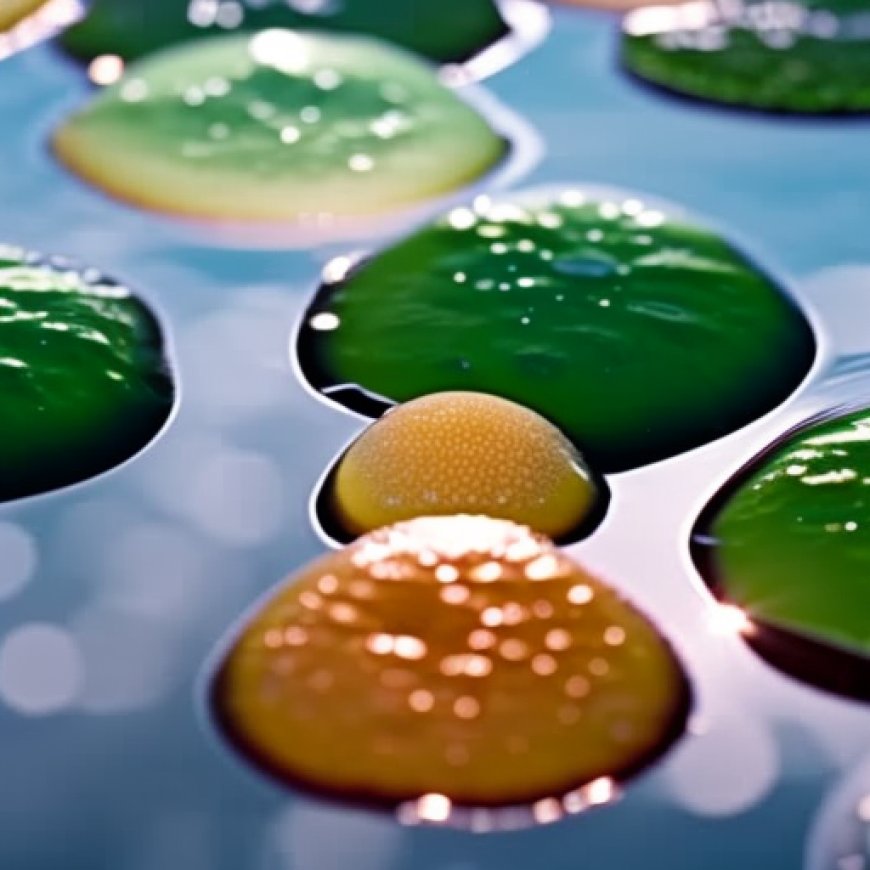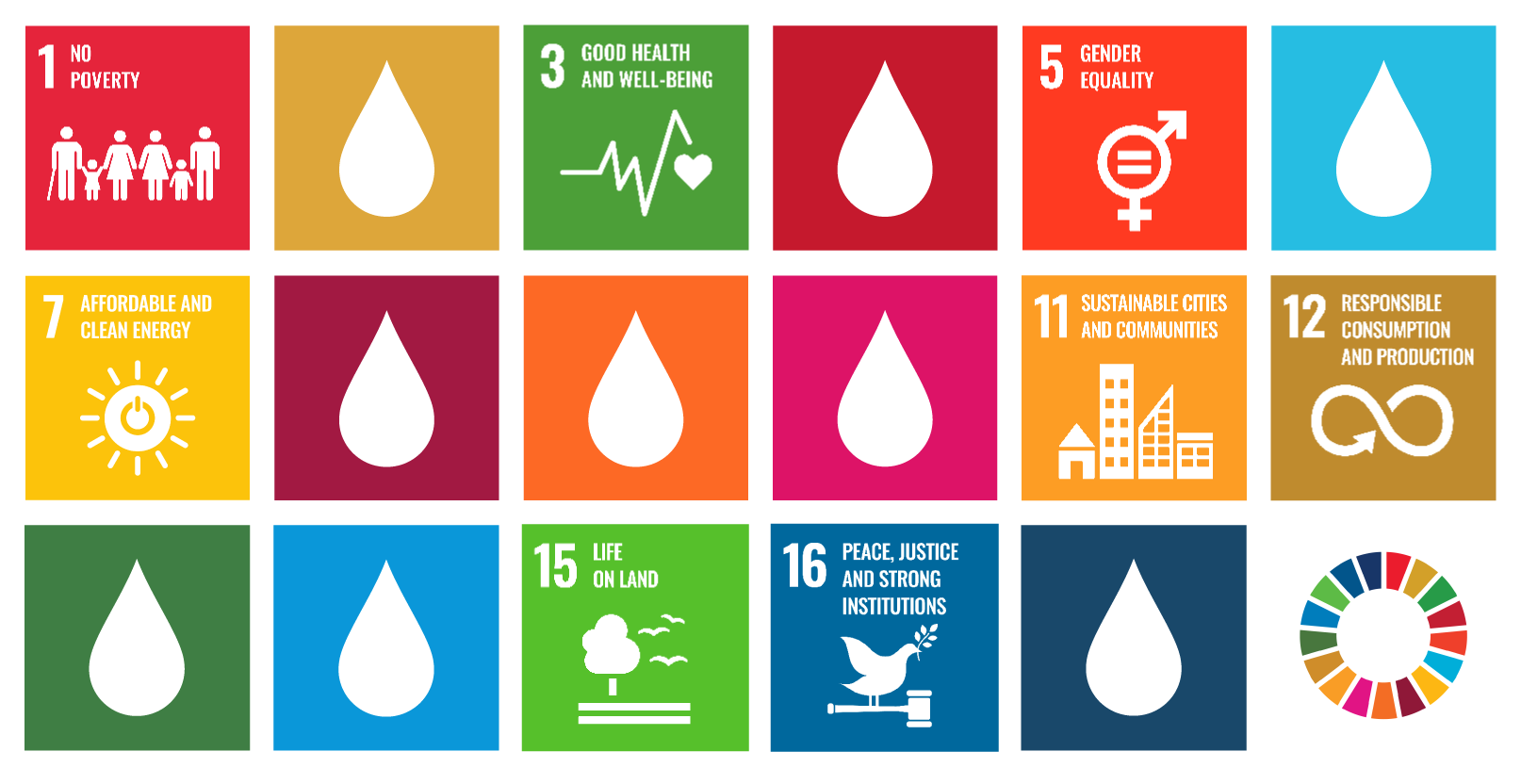Water is central in achieving all 17 SDGs. But how? | SIWI – Leading expert in water governance
Water is central in achieving all 17 SDGs. But how? | SIWI - Leading ... Stockholm International Water Institute



Sustainable Development Goals (SDGs) and Water
As of today, only 15% of the global targets defined in the 2030 Agenda for Sustainable Development are on track, and many are going backwards. But research shows that policymakers can still ensure that we achieve the 17 Sustainable Development Goals (SDGs).
So can we get there? How does water play a role, and why is it so central to all SDGs?
SDG 1 – No poverty
End poverty in all its forms everywhere
- 575 million people will face extreme poverty in 2030, with households being deprived of access to essential services, most notably sanitation and drinking water.
- Access to running water removes barriers to economic growth for both individuals and society. Being able to wash hands with soap reduces the likelihood of sickness, leading to fewer missed days of work or school, both of which come at great personal economic cost.
- Governance and particularly water governance is a prerequisite to improve resilience and populations’ ability to better manage climate related and other risks.
- The global goals must recognize the local realities of how poverty is inherently linked to inequalities and the breakdown of social cohesion. Being aware of people in the most vulnerable situations is therefore crucial.
- This is exemplified by SIWI’s GoAL-WaterS programme, in collaboration with the Jordan Ministry of Water and Irrigation, began a monumental process to design a national framework as a response to prepare for drought events. Water and lack of access to its connected services is not only an indicator of poverty but also vital to ending extreme poverty and benefiting its related social protection and empowerment.
- Learn how water can bring hope in fragile contexts
SDG 2 – Zero hunger
End hunger, achieve food security and improved nutrition and promote sustainable agriculture
- Over 70% of water withdrawals are destined to support agriculture. Ending hunger is more than just about access to food. Effective agriculture and more sustainable practices such as in the Zambezi Watercourse, ensure production of more nutritious food per drop of water.
- Likewise, gains in water efficiency make more water available not only for agriculture but also for other purposes. Rainfed agriculture and making use of every drop is crucial, particularly in due to multiple climate stressors.
- This is why we need to invest rainfed agriculture
SDG 3 – Good health and well-being
Ensure healthy lives and promote well-being for all at all ages
- SDG 3 specifically sets out to end all water-borne disease epidemics, such as malaria, by 2030.
- Access to clean running water and sanitation facilities immediately contributes to improving public health. It is a cost-effective way of preventing health issues from arising, especially for children under the age of 5 who are more at risk of water-borne diseases. Access to water and sanitation services, for example in public spaces, is key to prevent spread of diseases such as Covid-19.
- Learn how SIWI contributes to achieving universal access to water and sanitation
SDG 4 – Quality education
Ensure inclusive and equitable quality education and promote lifelong learning opportunities for all
- Schools that incorporate water and sanitation facilities enable children to attend school more regularly and safely. However, the need to fetch water and cultural stigma around menstruation, still keep children, girls in particular, from attending classes.
- The relationship between water and education is also a two-way interaction: If provided with quality water education, children can become drivers of change. They can share learnings and good practices in their families, instilling new behaviours in their communities.
- Ensuring that children attend school and that they are educated about the interconnection between water, health and other environmental challenges, can help them become more qualified adults who can contribute to future water, sanitation and hygiene services.
- Through the WASH-BAT approach, SIWI and UNICEF support communities to assess the constraints that prevent schools from having access to sustainable sanitation and hygiene services.
- This is how the WASH BAT methodology is applied in schools
SDG 5 – Gender equality
Achieve gender equality and empower all women and girls
- Equal access to water is at the heart of achieving gender equality. Women and non-binary people are still disproportionately affected by water insecurity, in part because they often do not enjoy the same tenure rights as men, and they are also more likely to suffer from gender-based violence arising from water insecurity.
- Women are often responsible for securing water at the household level, yet their contribution often goes unrecognized within the formal economy. Poverty and lack of empowerment are particularly related to women’s rights and rights to water access. The SDGs need to acknowledge this gender disparity in their acknowledgement of local realities. Providing equal access to water
SDGs, Targets, and Indicators
SDGs Targets Indicators SDG 1 – No poverty End poverty in all its forms everywhere – 575 million people will face extreme poverty in 2030
– Deprivation of access to essential services, including sanitation and drinking waterSDG 2 – Zero hunger End hunger, achieve food security and improved nutrition and promote sustainable agriculture – Over 70% of water withdrawals are for agriculture
– Sustainable agriculture practices for more nutritious food productionSDG 3 – Good health and well-being Ensure healthy lives and promote well-being for all at all ages – End water-borne disease epidemics
– Access to clean running water and sanitation facilities for improved public healthSDG 4 – Quality education Ensure inclusive and equitable quality education and promote lifelong learning opportunities for all – Schools with water and sanitation facilities for regular attendance
– Water education for children to become drivers of changeSDG 5 – Gender equality Achieve gender equality and empower all women and girls – Equal access to water to reduce gender-based violence and empower women
– Gender transformative leadership for decision-makingSDG 7 – Affordable and clean energy Ensure access to affordable, reliable, sustainable and modern energy for all – Water required for energy generation
– Increased energy efficiency for water resource availabilitySDG 8 – Decent work and economic growth Promote sustained, inclusive and sustainable economic growth, full and productive employment and decent work for all – Water access and sanitation facilities in workplaces
– Improved water governance for economic growthSDG 9 – Industry, Innovation and infrastructure Build resilient infrastructure, promote inclusive and sustainable industrialization and foster innovation – Consider water in innovation and infrastructure development
– Indigenous knowledge for inclusive innovationSDG 10 – Reduced inequalities Reduce inequality within and among countries – Universal access to safely managed water, sanitation, and hygiene to reduce disparities
– Inclusive governance with a human rights-based approachSDG 11 – Sustainable cities and communities Make cities and human settlements inclusive, safe, resilient and sustainable – Sustainable, reliable water supply for reduced environmental impact
– Integrated approaches to climate change in citiesSDG 12 – Responsible consumption and production Ensure sustainable consumption and production patterns – Regulating and measuring water use for sustainable production and consumption
– Safe management and reuse of wastewaterSDG 13 – Climate action Take urgent action to combat climate change and its impacts – Sound water management for climate resilience
– Concrete, measurable commitments for climate actionSDG 14 – Life below water Conserve and sustainably use the oceans, seas and marine resources for sustainable development – Integrated management of water from source-to-sea for biodiversity protection
– Addressing the impact on land, coastal areas, and the oceanSDG 15 – Life on land Protect, restore and promote sustainable use of terrestrial ecosystems, sustainably manage forests, combat desertification, and halt and reverse land degradation and halt biodiversity loss – Consideration of water flows in forestry and agricultural practices for climate and biodiversity protection
– Healthy forests and wetlands for limiting global warmingSDG 16 – Peace, justice and strong institutions Promote peaceful and inclusive societies for sustainable development, provide access to justice for all and build effective, accountable and inclusive institutions at all levels – Transboundary water cooperation to minimize conflicts and support peace
– Inclusive governance with a human rights-based approach to reduce inequalitiesSDG 17 – Partnership for the Goals Strengthen the means of implementation and revitalize the Global Partnership for Sustainable Development – Cooperation across boundaries for achieving the SDGs with the help of water
– Engaging in international processes for collective actionBehold! This splendid article springs forth from the wellspring of knowledge, shaped by a wondrous proprietary AI technology that delved into a vast ocean of data, illuminating the path towards the Sustainable Development Goals. Remember that all rights are reserved by SDG Investors LLC, empowering us to champion progress together.
Source: siwi.org

Join us, as fellow seekers of change, on a transformative journey at https://sdgtalks.ai/welcome, where you can become a member and actively contribute to shaping a brighter future.







